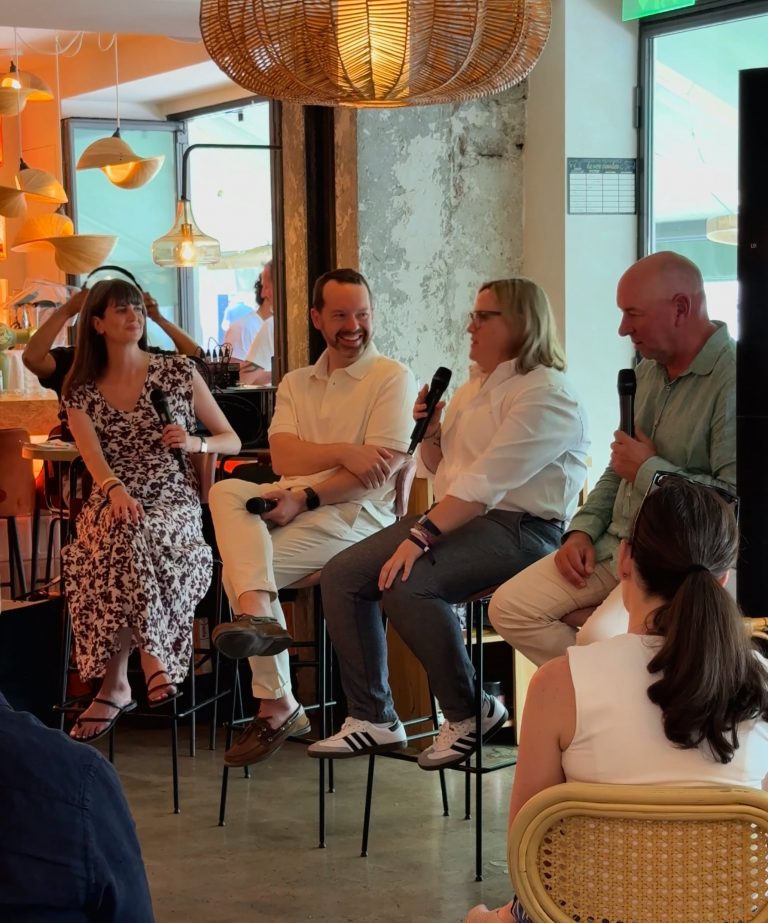The 2025 Retail Media Measurement Breakfast in Cannes brought together industry leaders to tackle one of the most pressing and complex issues in retail media today: measurement. Panelists explored how in-store retail media is evolving beyond its reputation as a “black box” and stepping into a new era of precision, accountability, and strategic value.
Moderated by Sarah Marzano, Principal Analyst at EMARKETER, the conversation featured insights from Collin Colburn (IAB), Liz Roche (Albertsons Media Collective), and Ben Reynolds (Walkbase). Their discussion underscored a clear and urgent theme: measurement is no longer a nice-to-have — it is a must-have for building trust and sustaining investment in in-store retail media.
In-Store Retail Media Spending: Growth Fueled by Accountability
According to EMARKETER, U.S. in-store digital retail media ad spending is expected to more than double from $430 million in 2025 to more than $1 billion by 2029. This growth isn’t just about the rapid increase of digital screens in retail stores; it’s driven by advancements in attention signals, measurement tools, and closed-loop attribution that allow in-store campaigns to be treated as serious components of the broader media mix.
“In-store is finally moving out of the potential phase and into the execution phase,” said Marzano, summarizing the shift.
From Proof of Play to Performance-Based Planning
Liz Roche, VP of Media and Measurement at Albertsons Media Collective, noted that while retailers have always understood the power of the store as a touchpoint, the technology to prove its value is finally catching up. Albertsons sees over 36 million in-store shoppers per week — a staggering number that makes the in-store environment ripe for impactful campaigns. But proof is essential.
“What we’ve seen is an explosion of measurement technology,” said Roche. “It helps us go beyond proof of play and actually understand addressable impressions and ultimately connect them to purchases in the same trip.”
Sensor data, including Walkbase millimeter wave sensors and cart-based tracking, are playing a key role in this evolution, offering privacy-conscious ways to understand actionable data such as foot traffic, dwell time, and even product-level engagement at sub-meter granularity.
The Technology is Ready — But Adoption Takes Time
Collin Colburn, VP of Commerce and Retail Media at the IAB, emphasized that while definitions and standards are in place, adoption won’t be instantaneous. “These are hard things to implement,” he cautioned. “Just because we’ve published standards doesn’t mean they’re universally adopted yet. It’s going to take time.”
Still, Colburn pointed to retailers with large in-store footprints, and the customer data to match, as likely early movers in adopting retail media network solutions. Meanwhile, newer or non-traditional players entering the commerce media space might leapfrog more established players by building with standards in mind from day one.
Advertiser Appetite: Expanding Beyond Endemic Brands
One of the biggest shifts, according to Roche, is the growing interest from non-endemic brands. Financial services companies like PayPal now want access to retail media inventory, recognizing the value of reaching consumers at peak attention during their shopping trips.
“In-store is truly a full-funnel experience,” Roche said. “You can be inspired, you can discover, you can sample and then you can purchase.”
This momentum aligns with a broader truth that kept resurfacing throughout the panel: around 80–90% of retail transactions still occur in physical stores. For grocery specifically, the number is even higher. Brands want a piece of that high-intent, high-volume environment — and now, they want the measurement to prove it’s working.
Measurement as a Force Multiplier — and Culture Shifter
Ben Reynolds, VP of Business Development at Walkbase, a STRATACACHE company, emphasized that the newest measurement tools can go well beyond foot traffic. They capture nuanced shopper behaviors to deliver insights at scale.
“Retailers can now measure every ad unit, every screen, and tie it back to transactional data in a privacy-compliant way,” said Reynolds. “This gives retailers a massive dataset that can be folded into their customer data platforms and used to make smarter decisions.”
The implications go beyond campaign performance. Measurement data is now being used to influence store layouts, product placements, and even content strategy on screens.
Creativity Has Entered the Chat
Historically, the creative content element in retail media has lagged behind. But panelists agreed that in-store with its dynamic, full-motion screens and context-rich environments, offers a unique opportunity to reimagine storytelling.
“No one’s leaving the store screen to take a bathroom break,” joked Roche, contrasting it with traditional TV ads. “You’ve got a captive audience. Why not be inspirational?”
From recipe content and immersive videos to time-of-day personalization based on shopper flow data, in-store screens have the potential to become powerful canvases for creativity.
Internal Buy-In: A Team Sport
Finally, the conversation turned to organizational dynamics. For in-store retail media to succeed, it has to be more than a media team initiative. Roche shared that Albertsons has leaned into cross-functional education, bringing merchandising, operations, and store leaders into the conversation.
“Being able to go to the store directors and ask, ‘What do you want to know about retail media?’ has been transformational,” she said.
Colburn echoed that the success of in-store retail media could be the catalyst that redefines retailer-brand partnerships entirely, collapsing silos between trade, brand, shopper marketing, and media.
“If we do in-store well, it’s going to force brands to rethink how they operate,” Colburn predicted. “We’re on the verge of rewriting the rules.”
Final Thought: Crawl, Walk, Run
While challenges remain, the tone of the panel was overwhelmingly optimistic. The tools are improving. The appetite is growing. And the retail media industry appears ready to take the next step — one that doesn’t just prove in-store media works, but shows how it can elevate the entire shopper experience.
“We’re painting the horizon,” said Roche. “And now we’re starting to see what’s actually possible.”
